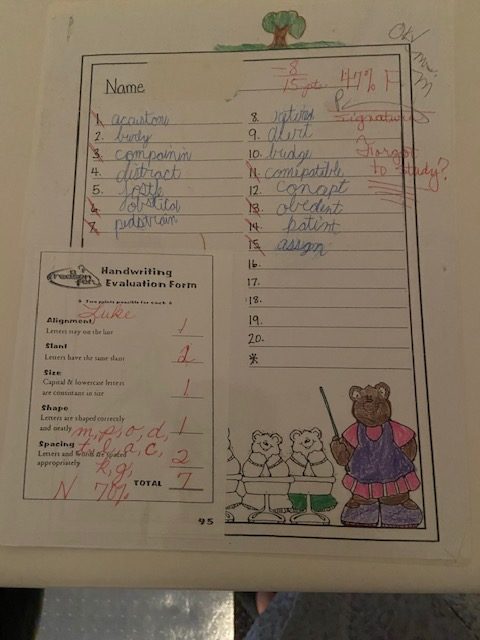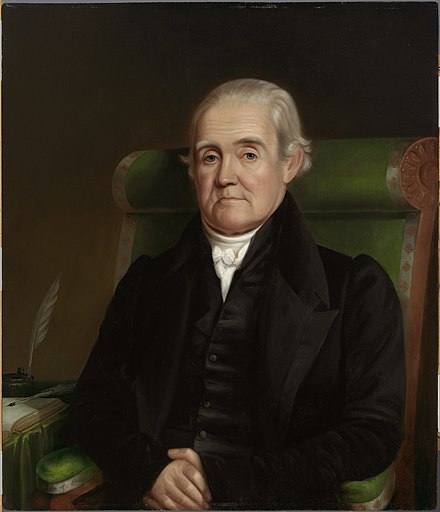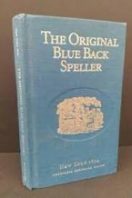A parent recently posed this question to a Facebook Group I help moderate:
My 1st grade son is experiencing difficulties with isolating phonemes and blending. He still cannot decode. His general education teacher refused to use the strategies that help him in her reading instruction and has promised to modify/differentiate his work, specifically spelling words and homework. Instead, she just keeps sending home the class spelling words and marks him as all incorrect on every spelling test. Is there a reason why a teacher would NOT modify spelling words? Is there a benefit to having him fail every week? I need some advice before speaking with his teacher. TIA
My question is this:
WHY is this STILL HAPPENING in 2021???
It happens to first graders and the image below shows you what happened to one of my former students, Luke, in fifth grade.
MEET LUKE:
This test was passed along to me prior to my completing an assessment on his reading, spelling, and written language. Every time I think about this, I become angry. Why?

1-The red pen….I suspect many of you have less than fond memories of red ink bestowed upon your work as students. It is everywhere on this paper without taking the time to show Luke the correct spellings of the words he missed.
2-The sarcasm… “Forgot to study?” Underlined no less than FOUR TIMES. Students like Luke may have studied, or may have just ‘given up’ since the task of memorizing 15 unrelated words seemed overwhelming, especially if the student did not have adequate instruction ahead of time in terms of the many and various letter patterns which comprise English spelling.
3-The ‘Handwriting Evaluation’…was this necessary for this student, or any student while taking a ‘spelling’ test? Is his work really an ‘N’ (70%). I say that if a student’s writing is legible (reasonably easy for others to read) and serviceable (easy for the writer to write), that is all it needs to be and does not need ‘evaluation’ or a ‘grade’. In this case, the answer is clearly “No”.
Luke was actually a very interesting student. Why was he having an assessment? He told me he was “sick of always needing to have his parents’ signatures, and then getting grounded.”
You see, his older sister was also my student. A. was in the midst of remediation and was still announcing to her siblings that she was “going to art lessons” rather than tell them where she really was two afternoons each week. Once the word got out and Luke noticed that his sister was doing better in school, he asked his parents if he could also ‘go to tutoring’. Hence his initial assessment.
Luke’s Reading issues: none in comprehension, well developed oral vocabulary, mildly lagging fluency due to difficulties decoding unknown words, large repertoire of words recognized automatically
Luke’s Written Language issues: spelling really influenced his production, dislike of writing, confusion with grammar inhibited ability to construct age appropriate sentences.
In general, better spellers tend to be better readers, but one can maintain good reading comprehension and be a poor speller without direct instruction in spelling. Direct spelling instruction does impact reading ability. Reading and spelling are dependent on mapping speech sounds to print and are best taught in an integrated fashion rather than as isolated subjects.The idea is for students to connect sounds to letters, make connections to various meaningful parts of words such as suffixes (word endings which either are verb tense endings or tell the listener/reader the ‘job of the word’ in the phrase or sentence–otherwise known as the ‘part of speech’), prefixes (word beginnings which bear meaning), and meaning bearing word roots (i.e. words containing the root ‘spect’ always have to do with ‘looking’). I am sad to share with you that sometimes my students (Luke included) told me:
1-they received their ‘spelling lists’ on Monday as quiet time and their teachers had not even orally read the words with the class let alone discuss the spelling patterns.
2-the workbook pages or assignments (write each word 5 times, alphabetize the words, complete word searches, write a story/paragraph using at least 8 words, etc.) were distributed over the course of the week…by the way, research tells us that having students write the same word more than 3 times does nothing to help them ‘learn’ the correct spelling. In fact it is deemed ‘counterproductive’ (Gillingham & Stillman).
3-the words were often dictated so quickly my students did not have time to write them, let alone check them over.
4-”I learn ‘em for the Friday test and then I forget ‘em.”–C., 4th grader
Thus, it became the student’s problem if this was not easy for him or her…AND it became what I came to call “a part-time job” for the parents of these students who saw their children struggling week after week. Many families found this situation stressful week after week and resorted to asking their children’s teachers for their upcoming ‘new spelling list’ on Fridays rather than wait until Mondays so that “they could have the weekend to work on them.”
Do you picture yourself as one of these parents? What is wrong with this picture?
Some families of the students I worked with chose to ‘allow their children to fail’ the weekly spelling tests in order to ease the stress of family life (not working on the spelling lists all weekend and each evening) in hopes of obtaining accommodations and/or additional services for their children in the school setting while the child in question and I toiled with parental support week after week to ‘make order out of chaos’ (my description for teaching children English spelling conventions and tying this teaching to reading instruction).
I toiled with parental support week after week to ‘make order out of chaos’.
-Lori Josephson
I am elated to tell you that A. is a successful college graduate working in the art design field and Luke is in college as I type.
HOW DID WE GET INTO THIS MESS? THE HISTORY OF THE WEEKLY SPELLING TEST
Way back when, children were taught to read by learning to spell using Noah Webster’s Blue Back Speller, first published in 1783. It continued to be a best seller well into the 19th century. Letters and sounds were taught in a ‘connected fashion’. Although clearly unlike what is known today about how the brain learns to read, Webster was surely on the right path. Webster was known for breaking down complex tasks into their component parts and proceeding from more simple concepts to more complex concepts. Thus, the Blue Back Speller was arranged accordingly, first teaching the alphabet, the sounds of the consonants, vowels, syllables, simple words, more complex words, and sentences. Students were expected to learn skills to mastery prior to learning new skills, but were apparently required to learn long lists of words, as well as grammar. Webster desired to ‘Americanize’ and standardized American English and implemented changes which helped to improve the teaching of pronunciation, spelling and reading so that the new United States of America would be more homogeneous in terms of spelling and pronunciation. Although pronunciation dialectical differences exist in our country, spelling conventions are indeed consistent.
According to Schlagal and Trathen in an article written in 1998, spelling instruction shifted in the early part of the 20th century to lists of words often presented in alphabetical order, with no particular visual pattern (or ‘orthographic pattern’-the technical term) to “be memorized one by one.” By the 1930s, the emphasis shifted to the “most common words” and “shorter word length” being taught first. I think this makes some sense since it was felt that “children needed to know how to spell the words they needed for their writing.” BUT…this method will not teach children what they need to know about how sounds and letters ‘work’ nor how the English language is organized. It does not teach a student to make ‘order out of chaos’.
It was in the 1930s-1940s that the ‘practice-test-practice approach’ (Monday pretest, small amounts of study across a week, Friday test) with review built-in took hold in American classrooms and remained for decades, and in fact, remains to this day in many classrooms.
Only in the 1950s did ‘spelling experts’ note that spelling lists paid no attention to sound-letter correspondences. Thus, what would be called ‘basal’ spelling programs began to try to organize their lists with sound-letter correspondences in mind. That said, the lists were not optimally organized, often presenting too many correspondences simultaneously for too many children (I remember those lists from my own, my students’, my own children’s school days!).
The pendulum took a swing later in the 20th century, with the notion that ‘incidental’ teaching of spelling in was a good way for children to learn. That is, children would be learning to spell the words they used when learning the curriculum in the content areas (for example, science/social studies), as well as when learning to spell the words the children wanted to write when expressing themselves in the context of written language. In this case, “each word must be memorized as a separate item.” Furthermore, students given lists at their frustration level (those scoring <40% on a pretest) did not retain the words when tested in the six week review test nor were they able to transfer the patterns of words they ‘learned’ to words with similar patterns they had not specifically studied. This is the same time period as ‘Whole Language’ and is what is known now as ‘Balanced Literacy’ was used to teach children to read by “reading and immersion in literature.”
OK, so now it’s the 21st century, 2021, and we know a lot more about how human beings learn to read and spell. The human brain’s visual memory can only ‘hold’ letters strings of two or 3 letters, so how do we human’s learn to spell? Listed below are several research based ideas and strategies:
1-Spelling is dependent on sound to letter/letter pattern relationships.
2-English is a ‘regular’ language (~85% regular) with predictable spelling patterns based upon our sound/letter pattern relationships.
“Researchers have estimated that the spellings of nearly 50% of English words are predictable based on sound-letter correspondences…another 34% of words are predictable except for one sound.”
-Louisa Moats
3-Like Noah Webster, it is best to learn from more simple to more complex concepts, with mastery all along the way. Thus, focus on consonant sounds, short vowel sounds, and digraphs would be taught first, followed by more complex sound-letter relationships following a well thought-out scope and sequence.
4-Children should also be taught how to read and spell what are called ‘Non-Phonetic High Frequency Words’, only comprising about 15% of the English language. These are words such as ‘said’, ‘come’, ‘the’, etc. where the sound-letter correspondences do not ‘match up’ as expected. These variances need to be discussed and directly taught rather than simply by rote memorization. You may have heard of these as ‘Heart Words’, or ‘Trick Words’. The term ‘Sight Words’ is confusing and should be abandoned.
5-Emphasis on word parts such as suffixes, prefixes, word roots (as described earlier in this blog) should be an integral part of what children are taught.
6-When reading with children, do make a conscious attempt to point out the spelling patterns taught, particularly if review is needed and emphasizing the current concepts your children might be working on or find challenging, as well as the spellings of the Non-Phonetic High Frequency Words. Reading (visual–>auditory) and spelling (auditory—>visual-motor) are inverse relationships that absolutely are interdependent and build upon each other.
All of this goes right along with what is now known as ‘The Science of Reading’ in which children are directly taught about sounds (phonological awareness), letter-sound relationships (phonemic awareness) and follow a prescribed and well thought out scope and sequence (order of teaching), use decodable text based upon the letter-sound relationships learned. It is then that our children will understand how words ‘work’ and optimize their literacy skills. This method of teaching is optimal for children with and without most disabilities. Learn more about it by investigating My Favorite Resources on this website (and reading future blogs)!
PART 2 next time around….PREVIEW: I will share the rest of Luke’s spelling assessment and help you to analyze the errors he (and many other children) make in their attempts to ‘memorize’ their way through spelling…and school. Knowledge is power, so stay tuned.

